Auth0 Social Login Get User Info and Try Again
People look at social login as simply an easier style to log in. That's truthful, simply information technology'due south a fleck simplistic.
What gets disregarded is how the very best companies and stickiest products maximize social login not but at login but at every step of the customer journey. They pull user information to create more personal onboarding experiences and they pull social data to make addictive notifications that bring users back to the app.
Here are iii means to apply social login to meliorate conversion rates, get users to activation as quickly as possible, and re-engage and retain users. In brusk, social login helps you augment your funnel, turn users into customers, and drive down churn—which provides the footing for long-term and sustainable growth.
Increase Your Sign Upward Conversion Rate past twenty%
Social login makes it super simple to sign upwardly for a new product. You lot reduce friction by providing 1-click sign upwards rather than having to fill out multiple form fields, put in your email and select yet another password.

It'south no surprise then that social login helps lift conversion rates. The numbers vary wildly on exactly how much conversion rates amend—and in add-on, much of this information has been provided past social login providers themselves, who are obviously interested parties. However, the numbers generally show an improvement in conversion, and in some cases, very pregnant increases.
- "forty-60% increment in conversion rates with some reaching upwards of 130%"
- "Conversion rates increase anywhere from 20-40% after social login implementation"
- "Conversion rates increase up to 20%"
- "Both options (traditional course plus social login) converts 8.5% more website visitors to grade submitters"
- "Social login increases registration rates past up to l%"

Fifty-fifty MailChimp—which came out against social login after experimenting with it for a calendar month—showed a three.4% lift in conversion from landing to login. MailChimp ultimately decided to rip it out based on concerns around branding and design. Even so, given that MailChimp deals with tens of millions of visitors a week, a 3.iv% conversion charge per unit improvement captured a huge absolute number of people with a minimal amount of work.
Cardinal Takeaway
Per ounce of work, implementing social login is one of the quickest wins around for driving up your sign up conversion rates and widening your funnel.
"Implementing social login is ane of the quickest wins around for driving upwards your sign up conversion rates."

Tweet This
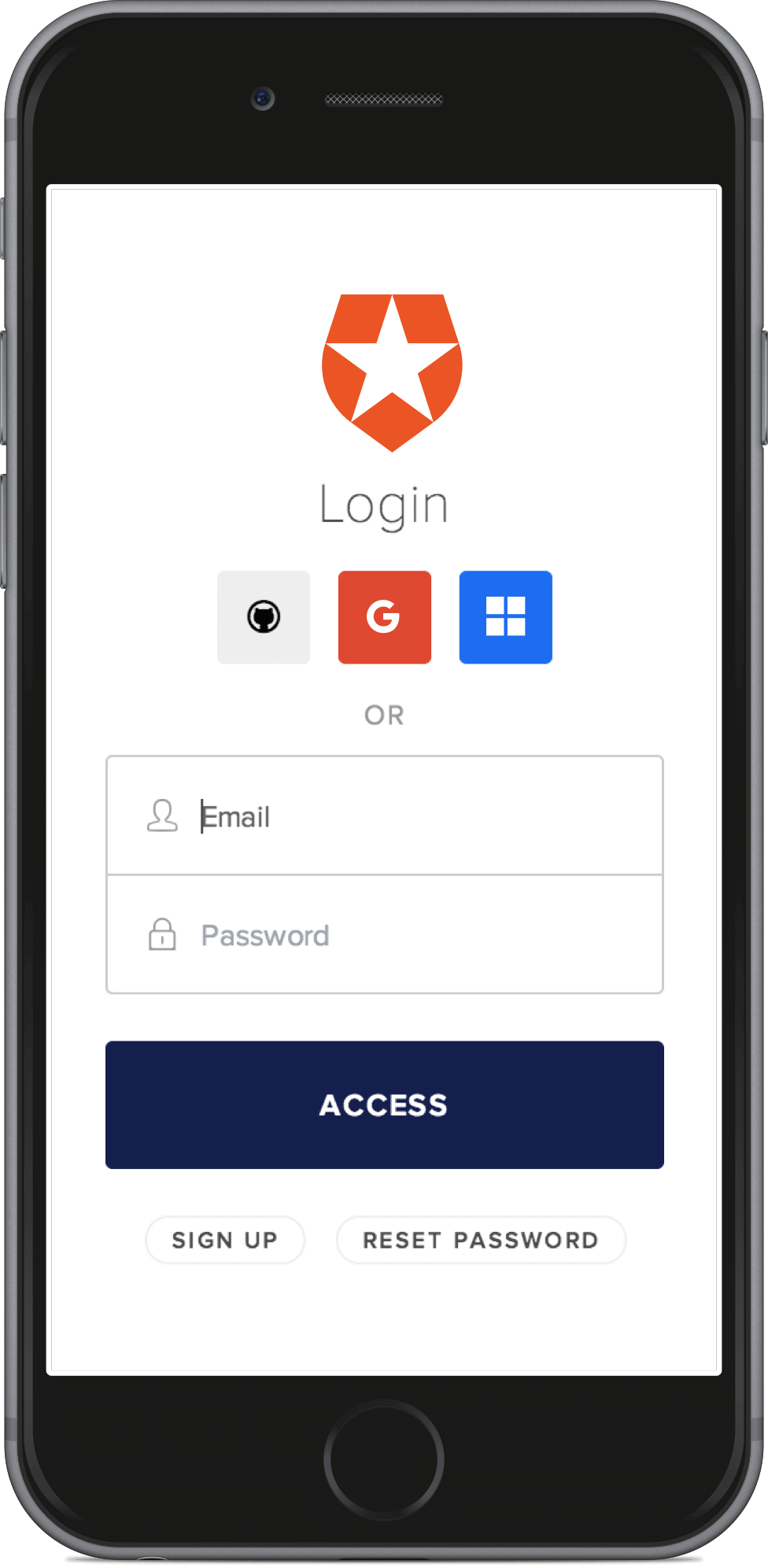
With an identity equally a service provider similar Auth0, you lot get nearly every social login pick without having to practise any additional work. Turning on a social login provider is a affair of flipping a switch rather than learning yet another API.
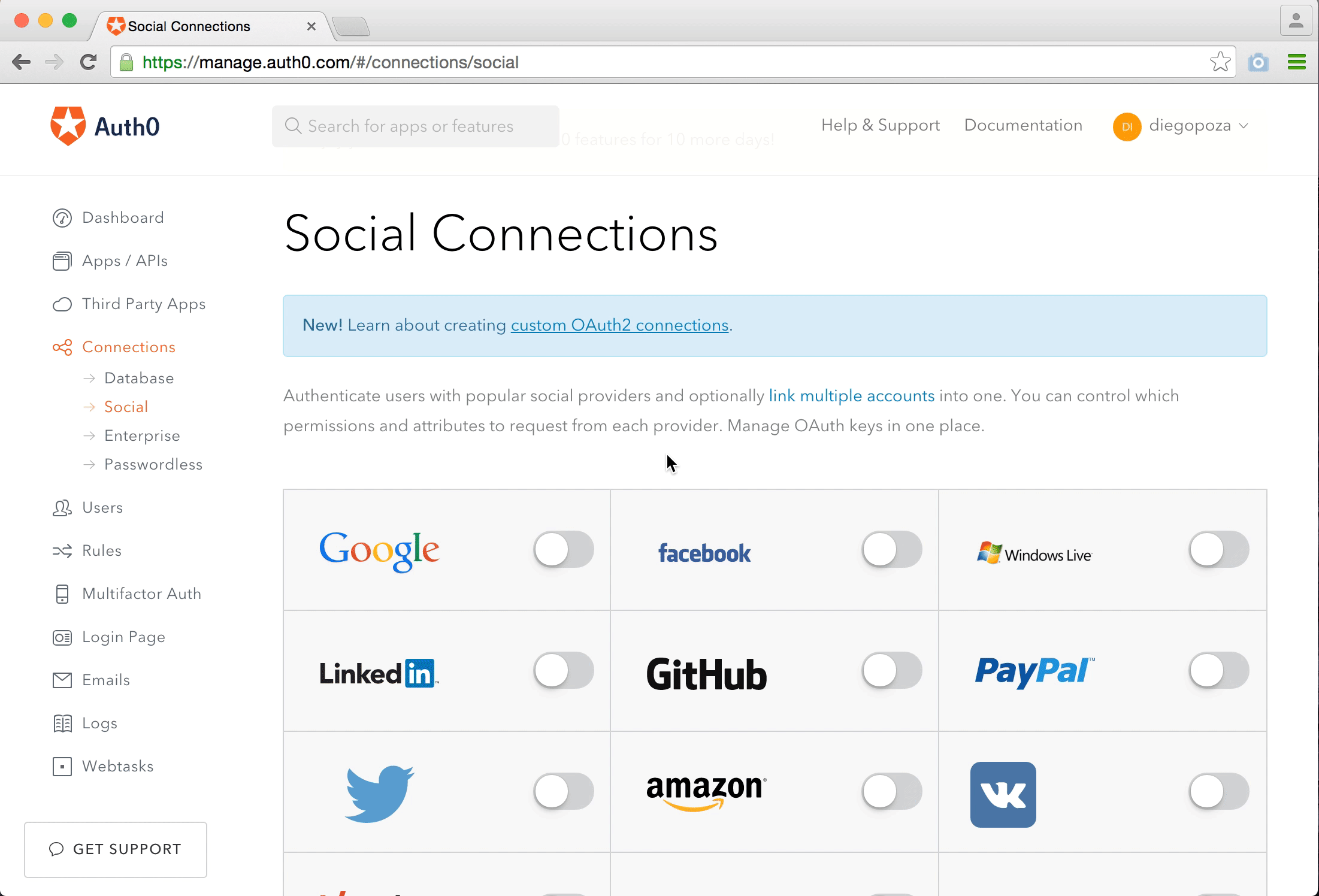
So customize the login to emphasize social login or even potentially just allow social login. A/B test dissimilar configurations to optimize your conversion rate.

Personalizing your onboarding flow is one of the well-nigh powerful ways to improve your activation rate and turn more trial prospects into paying customers.
But how can you personalize your onboarding flow for people you don't know anything about? They merely signed up and haven't used your product at all.
% include tweetquote.html quotetext="Personalizing your onboarding flow is one of the most powerful ways to improve your activation rate and turn more than trial prospects into paying customers. " %}
The respond is Facebook. Or Google, Twitter, GitHub and LinkedIn. On all of these social networks that nosotros use, nosotros've grown a massive bodies of data about ourselves that you lot as an app programmer tin employ to tailor a personal onboarding experience.
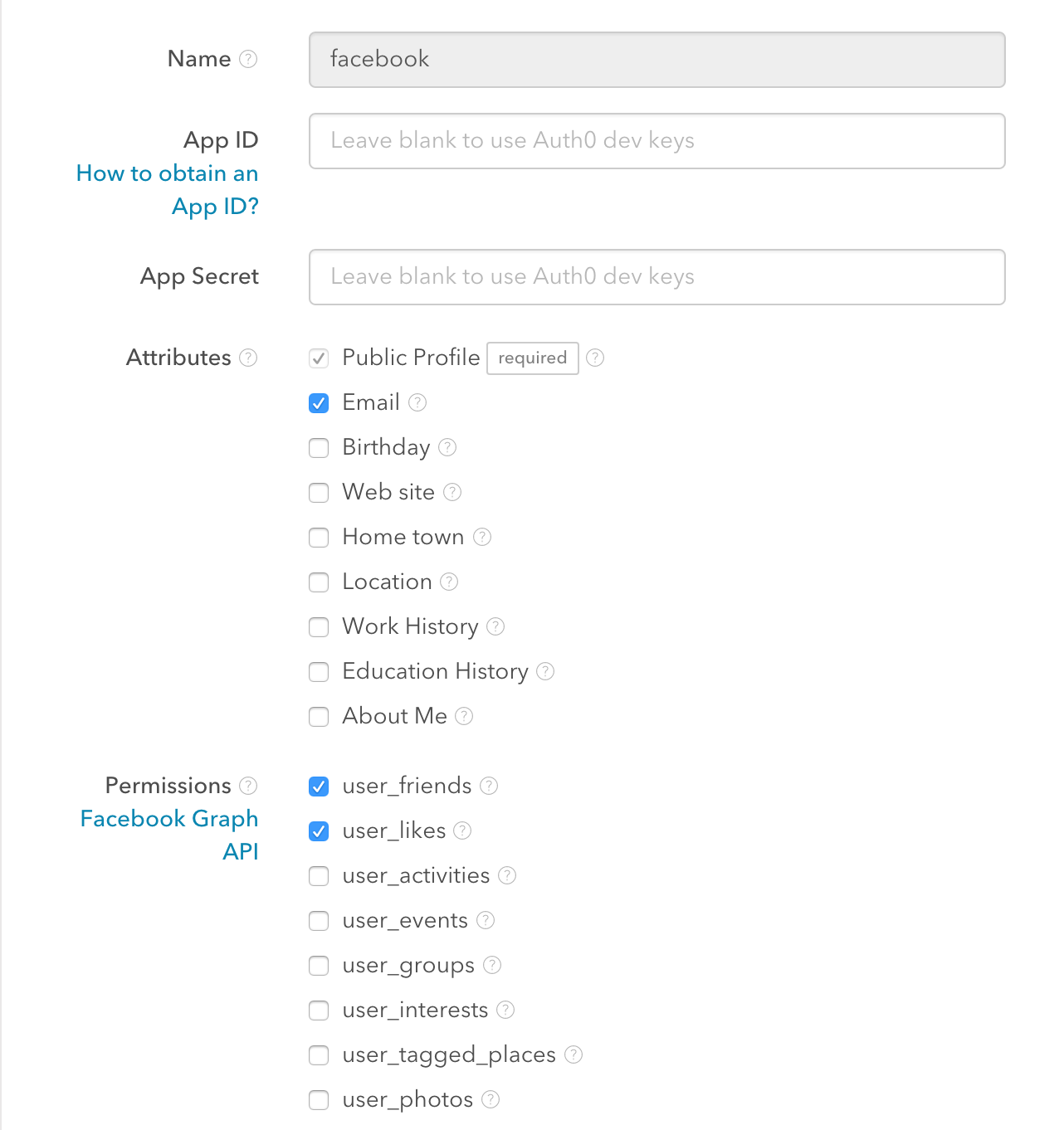
Here is a short list of user attributes yous tin can pull from Facebook via social login:
- Basic Profile
- Dwelling town
- Virtually Me clarification
- Location
- Birthday
- Website
- Education History
- Work History
- Friend List
- Friend's Likes
- User'south Likes
- And more . . .
You tin use all of that information to make the onboarding experience incredibly personal. For instance, after you sign up to Instagram via Facebook, the app's personalized onboarding menstruation kicks in and they prove yous your friends staring right back at yous.
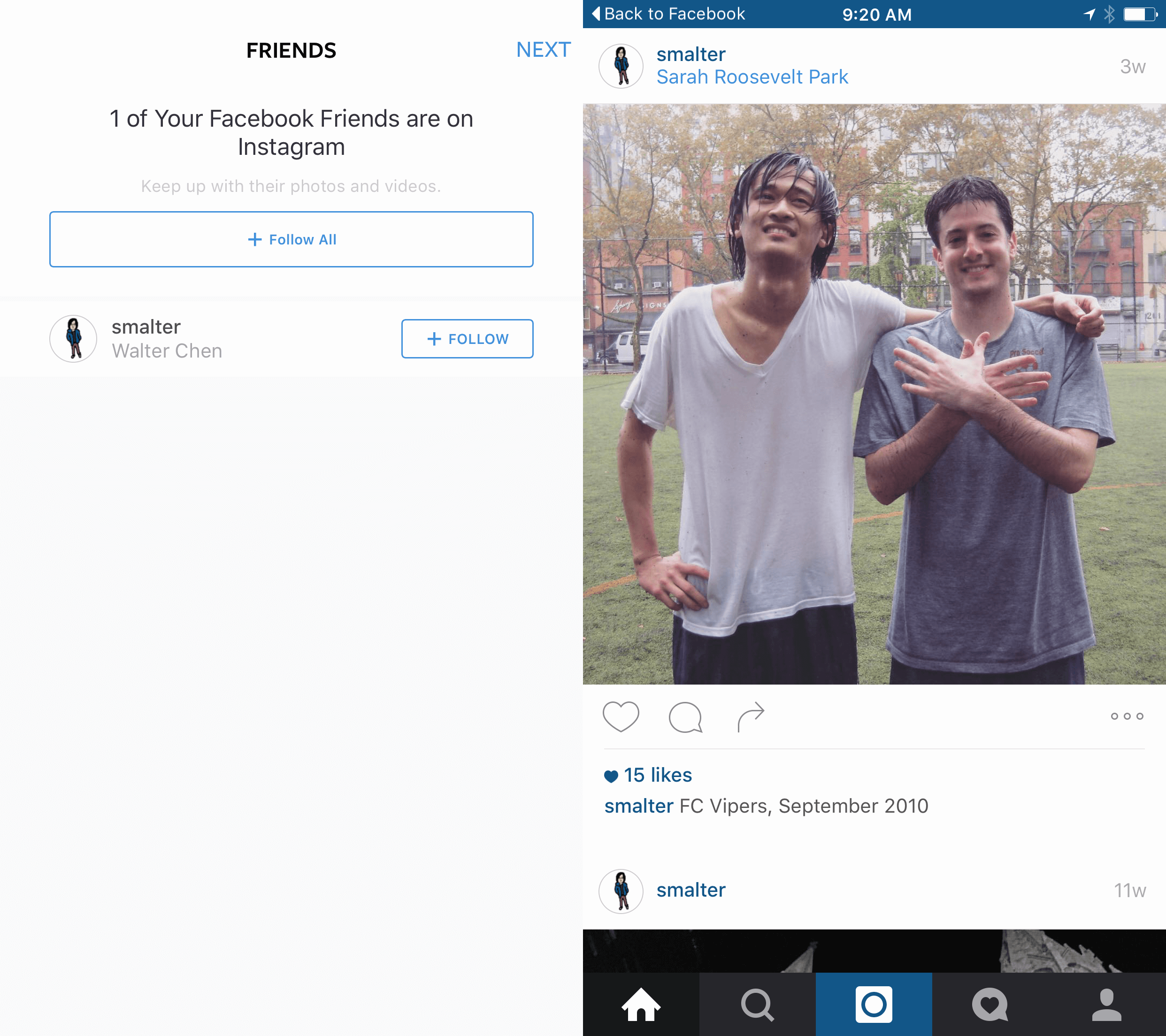
That gets you to the "aha!" activation moment very rapidly. Rather than having to build a follower list manually out of vague recommendations, the app is able to pull the exact people you want to follow (your friends) via Facebook Graph API after social login. You immediately have a highly relevant and personal feed, and that shows you the value of Instagram right away.
Instagram heavily emphasizes social login on their home screen. Log in with Facebook is the top and highlighted option, whereas email is put underneath in plaintext.
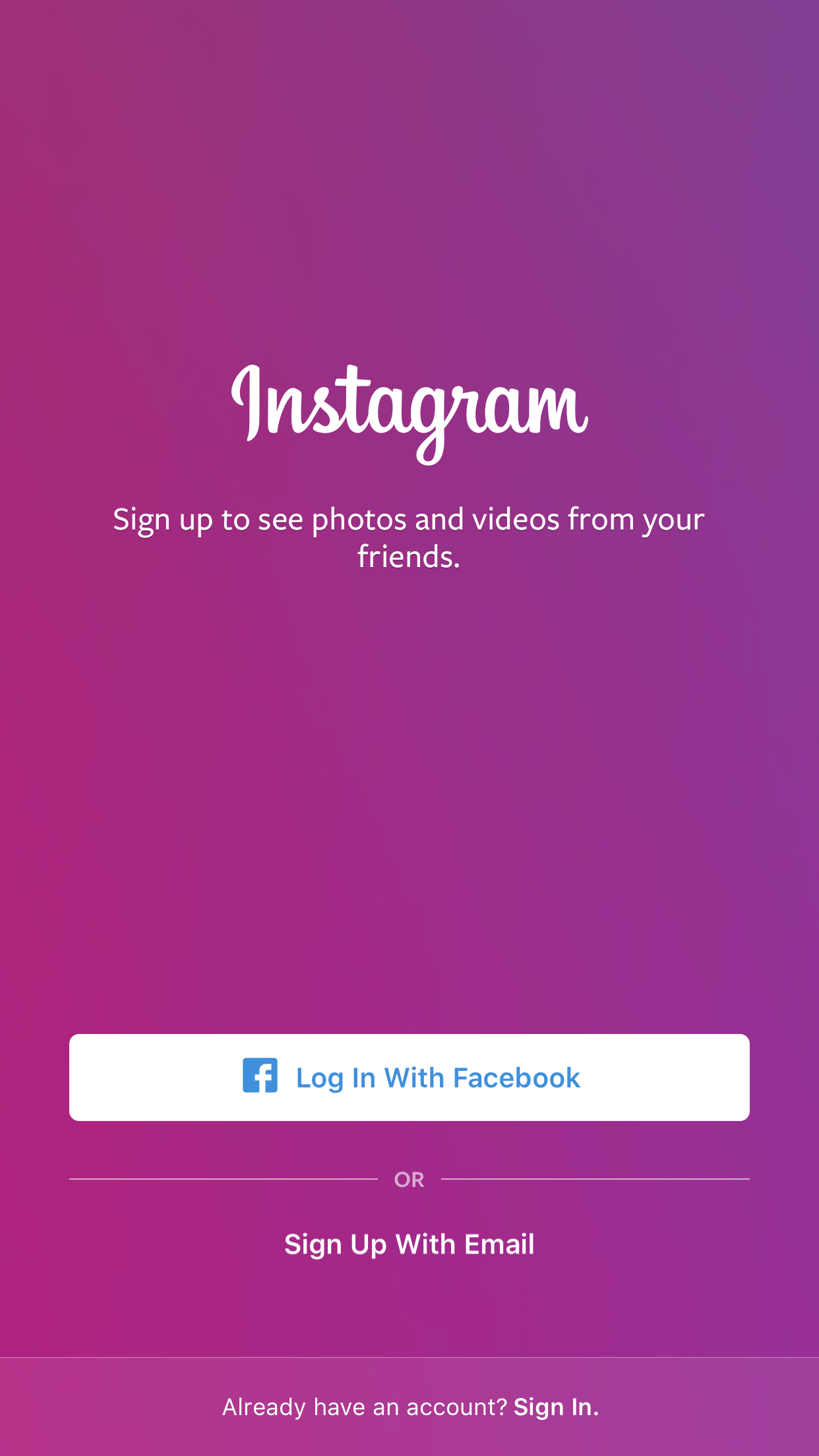
Primal Takeaway
Don't get out your onboarding flow generic, delivering the aforementioned feel to anybody no matter how unlike they are. Do whatever you lot can to personalize your onboarding flow. For many apps, that means pushing the user through social login and using the data culled from their network to create a highly personal onboarding feel.
Appcues is a user-onboarding-as-a-service that makes it super simple to create personalized user onboarding flows. As an incredibly piece of cake fashion to get started with personalized onboarding flows, take the info that you pull from social login and drop it into your onboarding messaging using simple user properties similar {aboutMe} , {website} and {educationHistory} .
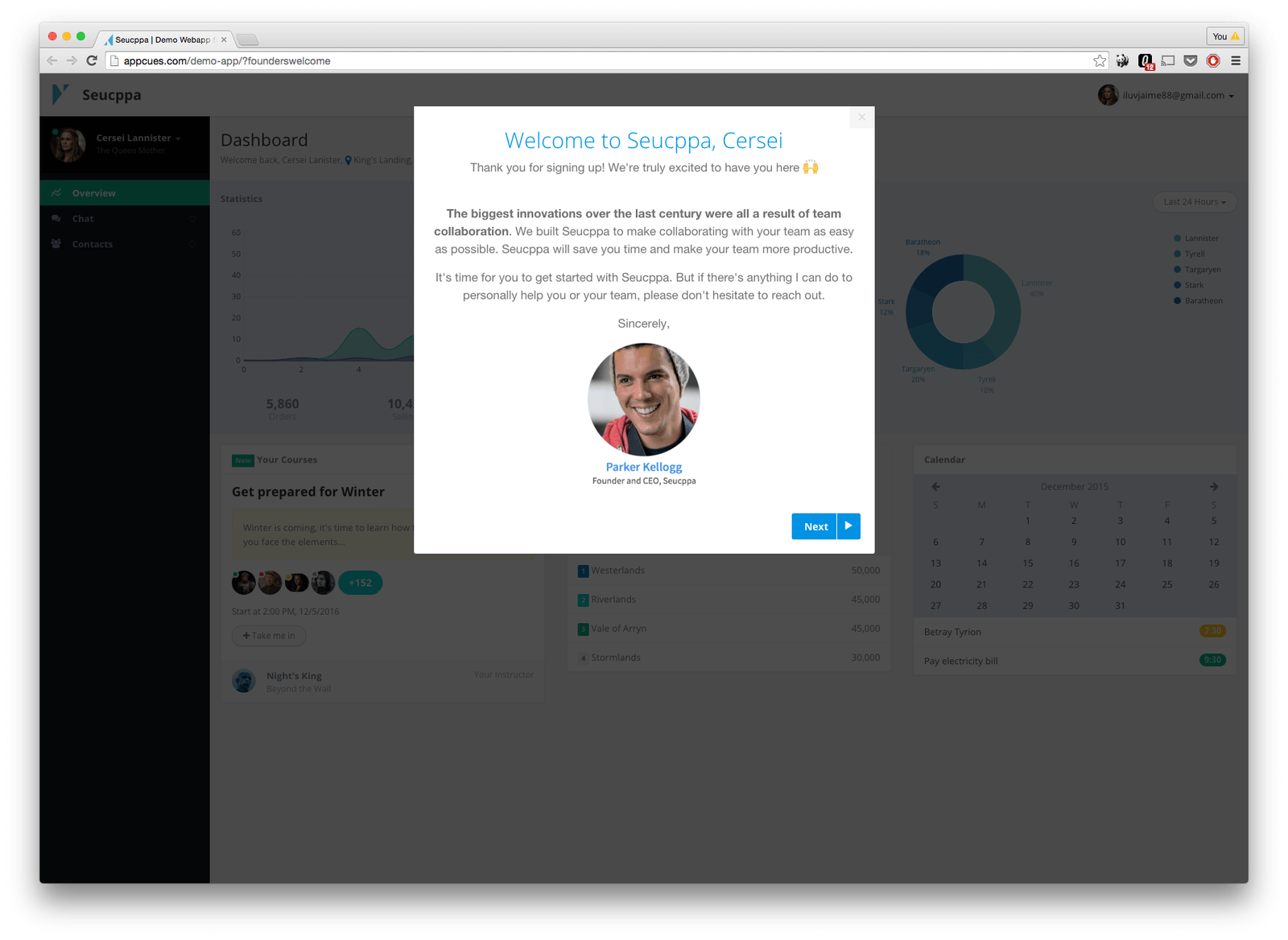
A more advanced technique is to distill social login information into buyer personas. For instance, suppose that you pull a user's job history from Facebook or LinkedIn social login. Yous tin can segment trial prospects into 4 groups, your 4 heir-apparent personas: engineer, marketer, product manager, and designer. Then giving each a different onboarding menstruum tailored to their user case.
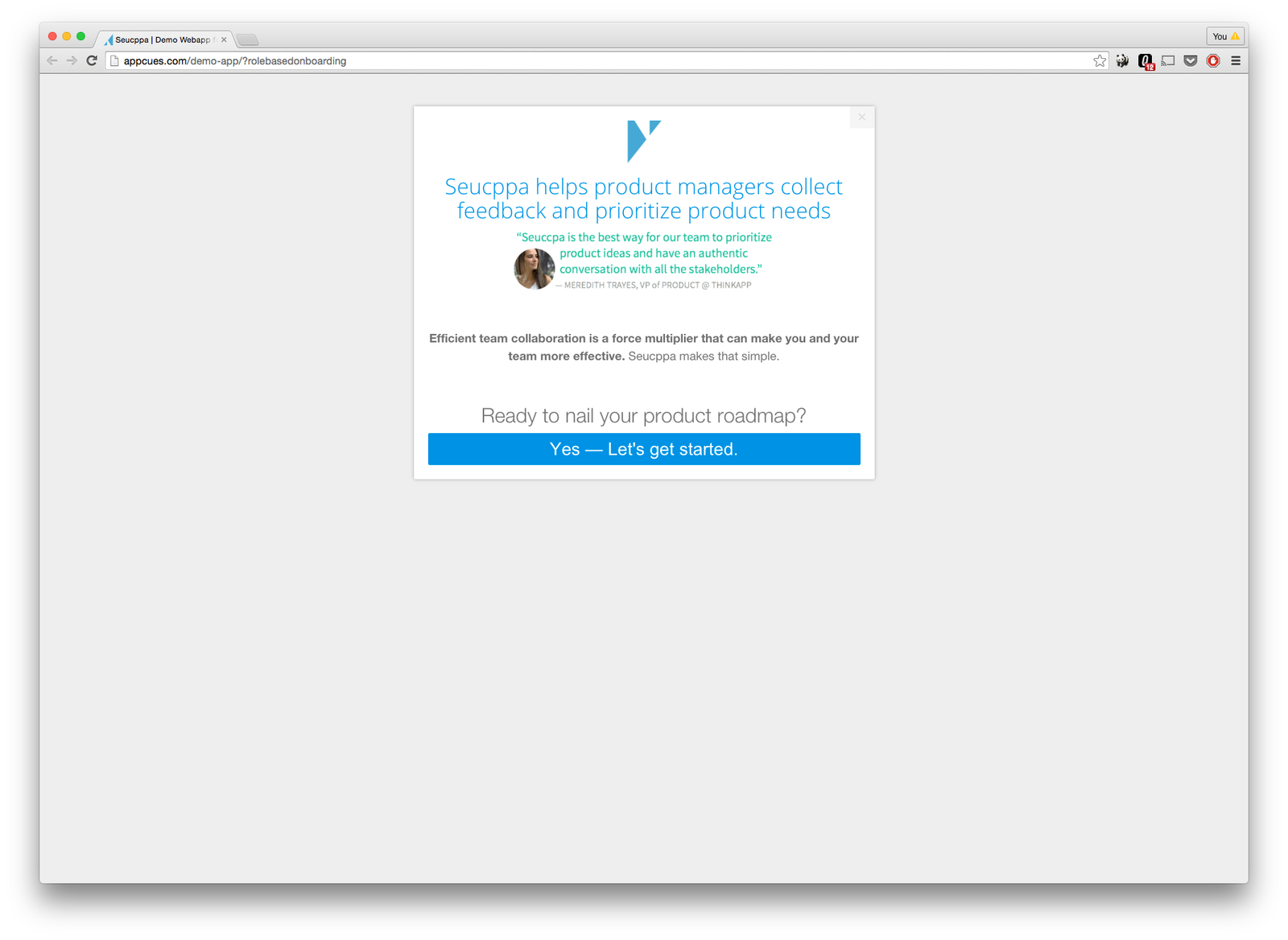
Drive 3x Date with Button and Email Notifications
Co-ordinate to mobile analytics platform Localytics, users who enable push notifications take nearly 3x the engagement charge per unit versus those who disable push. That's considering user notifications via button on mobile or email are 1 of the biggest drivers of engagement and re-engagement.
We're all familiar with notifications that tell us what has happened to us—for case, when someone likes or comments on our Facebook post. Or, when someone mentions us on Twitter or hearts our photograph on Instagram.
The problem with those notifications is that they crave that the users themselves are already active. In the words of former Facebook production managing director Meenal Balar: "We constitute that the notifications we were sending to our almost engaged users didn't make a huge impact — they were coming back to the site every 24-hour interval anyway."
Where you'll make the biggest impact with notifications is past engaging inactive users. Foursquare, for instance, is able to e-mail you with a personal, relevant message even if you haven't been active in the app. It will notify y'all with where your friends have been going and what they've been liking.
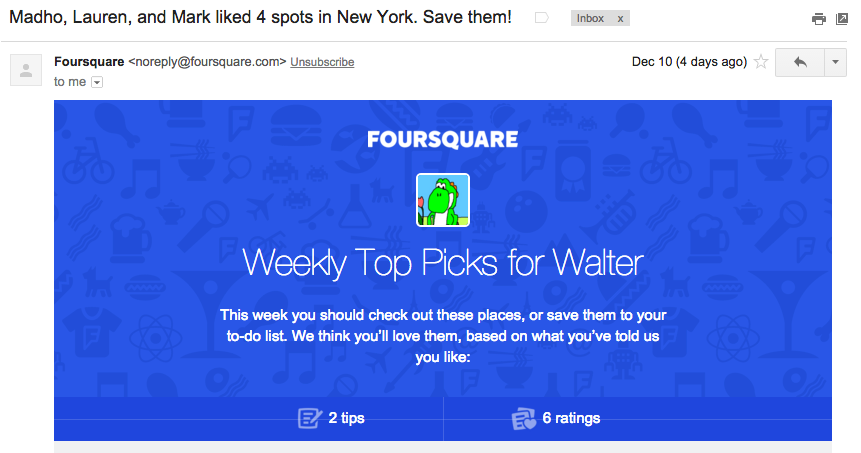
That shows the massive power of driving users to make friend and following relationships in your app. You lot can deliver effective notifications based on what connections are doing in the app because you know that they'll exist relevant and interesting to the user. To consummate the loop, the notification volition reactivate the user and get them back in the app.
It's social login that provides the basic social graph upon which your app's social graph will be built. Like in Instagram, as above, the moment yous sign upwardly, you can connect to the social graph you've painstakingly built on Facebook or Twitter. Further, as social connections bring together the app, you can notify the user and ask them to make that connection inside of your app as well.
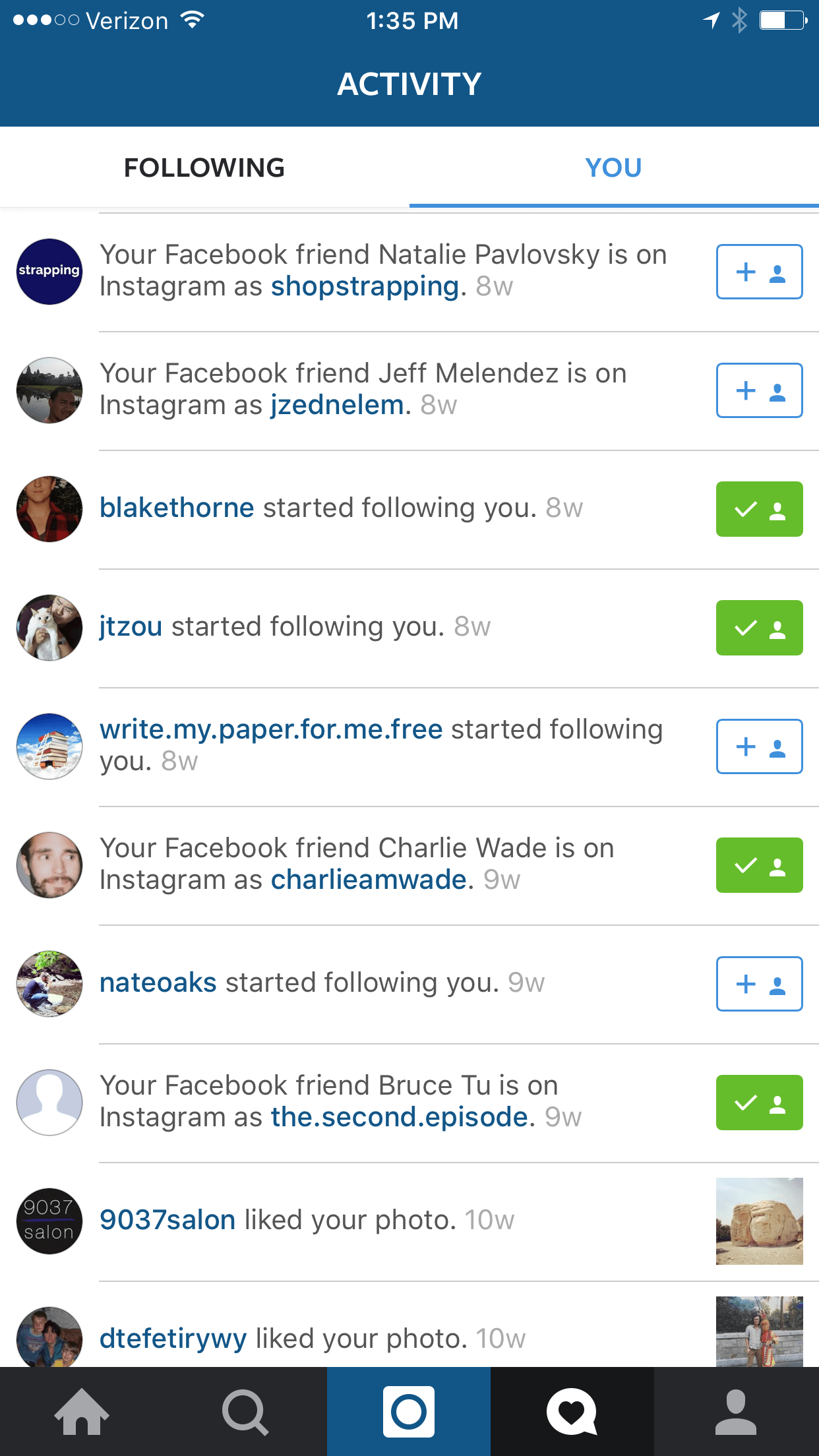
The upshot is that the user'due south social graph within of your app will exist stronger, and that will provide the basis for more than relevant notifications. This can re-engage your users in your app, showing them how their friends are using at the value they go from it. Ultimately, what you're aiming for is a "smile graph", where memory might dip initially, merely over fourth dimension, users get reactivated and they go active in the app once more. Retention then curves support and growth takes off.
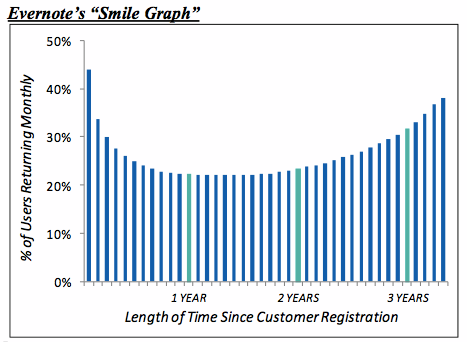
Key Takeaway
Social login strengthens connections in your app which provides the ground for notifications that improve retention. Make certain that you're using the information you get from social login over the entire client lifecycle, non only during onboarding.
To Janet Choi at Customer.io, notifications about what your friends are doing are among the nigh powerful because of a neurobiological mechanism in the human brain called the "framing effect." We as humans don't process wins and losses the same—we fear loss much more than nosotros enjoy proceeds. What results is the emotional trigger commonly known as FOMO, or fear of missing out, which is a powerful driver in social apps to become people to re-appoint to see what they're missing.
Customer.io is a SaaS product that makes information technology easy to send lifecycle emails based on what happens in your app. You can use information technology to prepare up a simple recurring email where you point out what your friends are doing in the app.
For instance, at social-location check-in app Swarm, they take a very literal approach to this tactic. Approximately every ii months, they sent out an email with the subject "You're missing your friends' check-ins". It includes a count of how many of my friends checked in and how many check-ins they logged with a phone call to action to satisfy your FOMO, open the app, and bring together in on the fun.
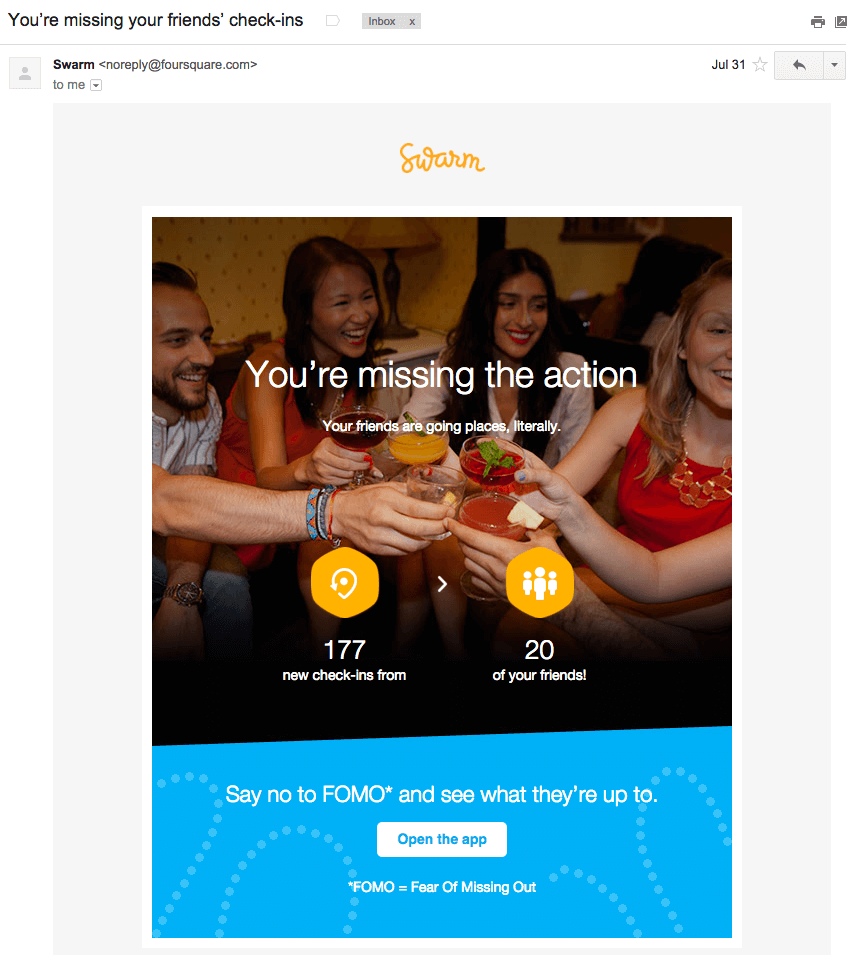
Information technology'south Meliorate Together
Social login is and then useful considering our social and professional connections provide the foundation for so much of what nosotros do both for fun and at work. Fundamentally, we rarely have fun and get stuff done alone—we do it in social and professional contexts.
When you connect via social login, yous're importing that context into the app to get up and running more quickly and to make the feel richer. Whether you lot accept the latest hot social consumer app or a B2B enterprise app, integrating social login is one of the simplest things you tin do to make every aspect of the user lifecycle more than sticky and drive growth.
Source: https://auth0.com/blog/how-to-use-social-login-to-drive-your-apps-growth/
0 Response to "Auth0 Social Login Get User Info and Try Again"
إرسال تعليق